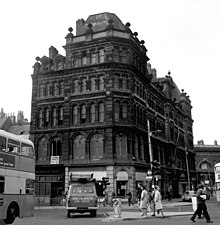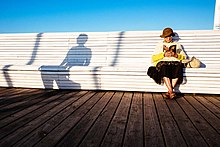Street photography


Street photography is a genre of photography that includes numerous photographers and styles. In general, this means a photograph that is created in urban public space, looking into the streets, into shops or cafes, picking out groups of passers-by or individuals, often as a snapshot, but also as an essay-like sequence and milieu study.
history
Already Eugène Atget Dating back to the late 19th century photographs of Paris and its suburbs of street photography can be attributed.
The heyday began in the 1930s with the possibilities of faster and more compact 35mm cameras , the emergence of magazines and the increased interest in everyday life and its facets. The street photography genre in particular has produced outstanding illustrated books , including, for example, Henri Cartier-Bresson's Images à la sauvette (1952), Robert Frank's The Americans (1959), Hildegard Ochses Café Mitropa (1980) or, more recently, Bruce Davidson's Subway (1986) and Saul Leiters Early Colors (2006).
style
In terms of composition and style, street photographs range from strict documentary shots to grainy, deliberately blurred or tilted views, daring perspectives and distorting reflections. The differences between documentary and so-called creative photography have been questioned in particular by photographers such as Lee Friedlander and William Klein .
criteria
There is no exact definition of street photography.
The following criteria are mentioned:
- Street photography shows a situation of the moment that will not appear again in exactly the same way, although the character of this situation should point beyond the moment and “reflect the essentials of place and time”: “Capturing a special moment is the high art of street photography, but the implementation of the special atmosphere of each location is just as important. "
- Mostly people are shown in an outside scene or situation; however, images of empty spaces can also meet the aforementioned criterion.
- The situation is authentic and documentary. To distinguish it from documentary photography , the author Clive Scott names the following features:
- Documentary photography focuses on a particular subject or subject, while street photography often takes a peripheral, random point of view - so that the viewer wonders who the subject of the scene is.
- Street photography shows the accidental, documentary photography the fateful moment.
- Documentary photography urges the viewer to judge, street photography leaves him the freedom of personal interpretation.
- Documentary photography urges the viewer into a confrontation, street photography allows him the position of the distant, often even ironic viewer.
- Photographed people are not meant as private persons, but as anonymous figures of a general human situation. A street photograph does not show a person known to the photographer in a pose, in contrast to the photography of the paparazzi also not a publicly known person, but a basic situation of everyday life in public space.
- Street photography is the product of chance and the photographer's quick capture of the special moment. The ability of the photographer, his familiarity with the subject, is expressed in the image and distinguishes street photography as an artistic genre.
criticism
A critical examination of this can be found in Michael Mahlke. Further aspects, evaluations and examples can be found at:
- Andreas Stelter.
- Till Schramm.
- Eric Kim names a plethora of online references on the subject.
Legal situation in Germany
In Germany, the publication of recordings of people is permitted by the general right of personality of the person depicted from Art. 2 Para. 1 in conjunction with Art. 1 para. 1 GG. and the publication of public scenes is restricted by the right to one's own picture . According to § 22 KunstUrhG, images may only be distributed or publicly displayed with the consent of the person depicted. However, Section 23 (1) no. 4 KunstUrhG makes an exception if the dissemination or exhibition serves a greater interest in art. However, according to Section 23 (2) of the KunstUrhG, this only applies to distribution and exhibition that does not infringe a legitimate interest of the person shown.
In 2014, the Berlin Regional Court decided in the event of street photography being exhibited as a street poster that the person depicted "in a purely private life process" in the public street space is entitled to an injunction. The decision was criticized for not having dealt adequately with artistic freedom and for having one-sidedly focused on the personality rights of the person depicted. The photographer's appeal was rejected by the Higher Regional Court in June 2015 . The Court of Appeal justified the decision by stating that the exhibition in the form of display boards in public space would expose the depicted person "as an eye-catcher to a broad masses" "and not, as is regularly expected in an art exhibition, to the viewing of art-interested visitors."
The Federal Constitutional Court has in its judgment of 8 February 2018, the judgment of the Supreme Court as unconstitutional, the same time found that street photography fall 1 GG within the scope of artistic freedom of art. 5 para. 3 sentence. When considering the personality rights of the person depicted, the courts would have to clarify in individual cases whether this impairment is so serious that the freedom of art has to withdraw; a minor impairment or the mere possibility of a serious impairment were not sufficient for this in view of the great importance of artistic freedom. The Court of Appeal had included the importance and scope of artistic freedom when assigning the portrait to the scope of application of Section 23 (1) No. 4 KUG and in the result of its weighing up within the framework of Section 23 (2) KUG and was also aware of the inherent laws of street photography done justice. By deducing the severity of the impairment of the plaintiff's personal rights from the way in which the picture was presented as a large-format eye-catcher on a public street, the Court of Appeal did not fail to recognize that it would not be compatible with artistic freedom to apply its scope to galleries, museums or to limit similar spatially limited exhibition locations, but made the particular violation of personality of the plaintiff by the highlighted presentation on a large-format plaque on one of the busiest streets of a metropolis the central point of his consideration. In this way, the Court of Appeal did not make it generally impossible to depict people without prior consent, which is typical of the structure of street photography.
International street photographers
- Henri Cartier-Bresson
- Bill Cunningham
- Bruce Davidson
- Philip-Lorca diCorcia
- Robert Doisneau
- Elliott Erwitt
- Robert Frank
- Lee Friedlander
- Bruce guilds
- André Kertész
- Saul Head
- Helen Levitt
- Vivian Maier
- Joel Meyerowitz
- Daidō Moriyama
- Martin Parr
- Petersen is different
- Marcus Schwier
- Shōmei Tōmatsu
- Ed van der Elsken
- Alex Webb
- Garry Winogrand
German street photographers and groups
Well-known street photographers in Germany include a. Chargesheimer , Andreas Herzau , Brigitte Kraemer , Hildegard Ochse , Friedrich Seidenstücker , Martin U. Waltz and Wolfgang Zurborn .
Numerous new street photographer groups have been founded since 2016. The following collectives exist in Germany:
- Berlin Street Photography Club, Berlin
- Berlin1020, Berlin
- Bremen Street Collective, Bremen
- Collateral Eyes, Frankfurt
- Munich Street Photography Collective, Munich
- Off Perspective (previously NRW35), North Rhine-Westphalia
- nuremberg unposed collective, nuremberg
- Street Photography Cologne, Cologne
- Unposed Society Hanover, Hanover
In addition, Soul of Street is a German street photography newspaper and the Deutsche Streetfotografie Seite is a platform for street photography in Germany, which also designed the German Street Photography Festival 2019.
literature
- Street photography made in Germany. Places, people and moments. The best recipes for great street photos. Rheinwerk, Bonn 2018, ISBN 978-3-8362-6117-3 . (With pictures and texts by ten German street photographers)
- Andreas Pacek: Photography. Street photography. The breath of the street. Franzis, Haar near Munich 2018, ISBN 978-3-645-60554-0 .
- Meike Fischer, Rudolf Krahm: Street photography course. Photographing scenes, people and places in urban space. 2nd, expanded edition. dpunkt, Heidelberg 2014, ISBN 978-3-86490-084-6 . (With bibliography)
Individual evidence
- ^ Gerhard Haug: Exhibition 2012 3 HaK. (No longer available online.) Archived from the original on March 28, 2017 ; accessed on March 27, 2017 . Info: The archive link was inserted automatically and has not yet been checked. Please check the original and archive link according to the instructions and then remove this notice.
- ↑ Ingeborg Ruthe: My picture of the week: Mitropa, second home . In: Berliner Zeitung . ( berliner-zeitung.de [accessed on March 27, 2017]).
- ↑ a b Sofie Dittmann: Introduction to Street Photography / Street Photography - Part 2/4: Does Street have to be compositionally / technically perfect? , focused.com, accessed September 6, 2012
- ^ A b Meike Fischer, Rudolf Krahm: Photography course street photography. dpunkt Verlag Heidelberg, 2012. p. 13. ISBN 978-3-89864-691-8
- ^ Clive Scott: Street Photography. From Atget to Cartier-Bresson. IB Tauris, London, 2007, p. 62. ISBN 978-1-84511-223-3
- ↑ a b c Scott, p. 65
- ↑ Michael Mahlke: Where Wikipedia is not enough , accessed on April 7, 2013
- ^ Andreas Stelter: On Street Photography , accessed April 7, 2013
- ↑ Till Schramm: Thoughts on the situation of street photography in Germany , accessed on April 7, 2013
- ↑ Eric Kim: Street Photography , accessed April 7, 2013
- ↑ Fotorecht-aktuell.de
- ↑ Photo rights, from page 46 ( Memento of the original dated December 16, 2011 in the Internet Archive ) Info: The archive link was inserted automatically and has not yet been checked. Please check the original and archive link according to the instructions and then remove this notice. (PDF; 2.4 MB)
- ↑ Comments by specialist lawyer Philipp Dorowski
- ↑ LG Berlin, judgment of June 3, 2014–2027 O 56/14 - Street Photography ( Memento of the original from March 4, 2016 in the Internet Archive ) Info: The archive link was inserted automatically and has not yet been checked. Please check the original and archive link according to the instructions and then remove this notice.
- ↑ Elmenhorst: Comment on LG Berlin, judgment of June 3, 2014–2027 O 56/14 - Street Photography, ZUM 2014, 734
- ↑ heise.de: Dispute about street photography: Photographer announces going to the constitutional court
- ↑ Startnext.com: Streetphotography Now, entry from June 29, 2015
- ↑ Non-acceptance decision of the BVerfG v. February 8, 2018 - 1 BvR 2112/15 -
- ^ Martin U. Waltz: Street Photography in Germany : Street photographers and collectives. In: Martin U Waltz. January 18, 2019, accessed on November 23, 2019 (German).
- ↑ Street photography groups in Germany • The German street photography site. In: The German street photography site. Accessed November 23, 2019 (German).
- ↑ Marieke Fischer: This is how absurd everyday life looks on Berlin streets. In: iD. March 15, 2019, accessed November 23, 2019 .
- ↑ Discovering Berlin through a cutting-edge street photography collective. Retrieved November 23, 2019 .
- ^ Introduction to Collateral Eyes Photo Collective. (PDF) In: Eye Photo Magazine Issue 11/2018. Stefan Cimer, November 3, 2018, pp. 34–51 , accessed on January 2, 2019 (English).
- ^ Martin U. Waltz: Street Photography in Germany : Street photographers and collectives. In: Martin U Waltz. January 18, 2019, accessed on November 23, 2019 (German).
- ↑ FREELENS German Street Photography Festival 2019 in Hamburg. In: FREELENS. May 28, 2019, accessed on November 23, 2019 (German).
Web links
- Katja Engler: Unusual insights into the art of photography. In: Abendblatt.de. March 4, 2016, accessed January 3, 2019 .